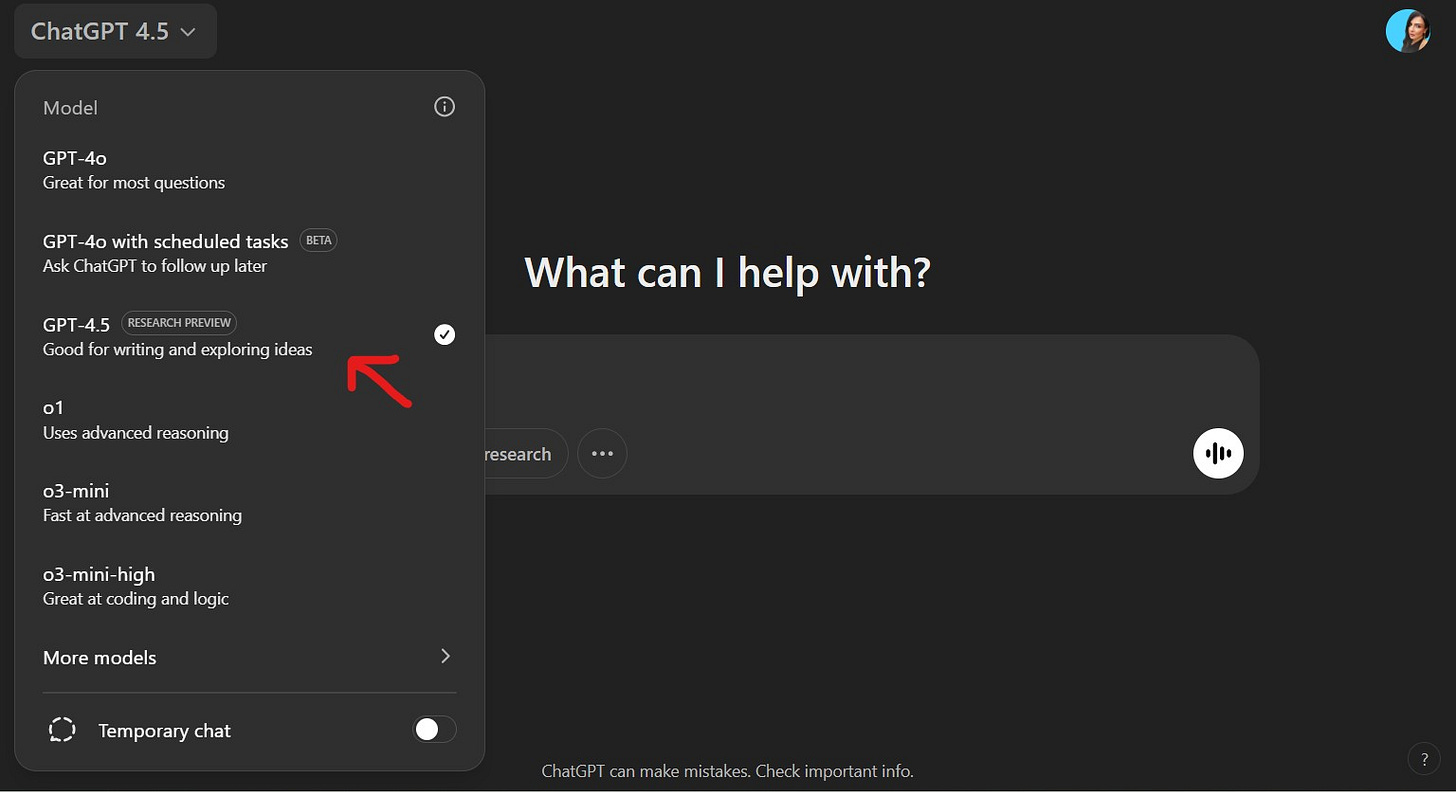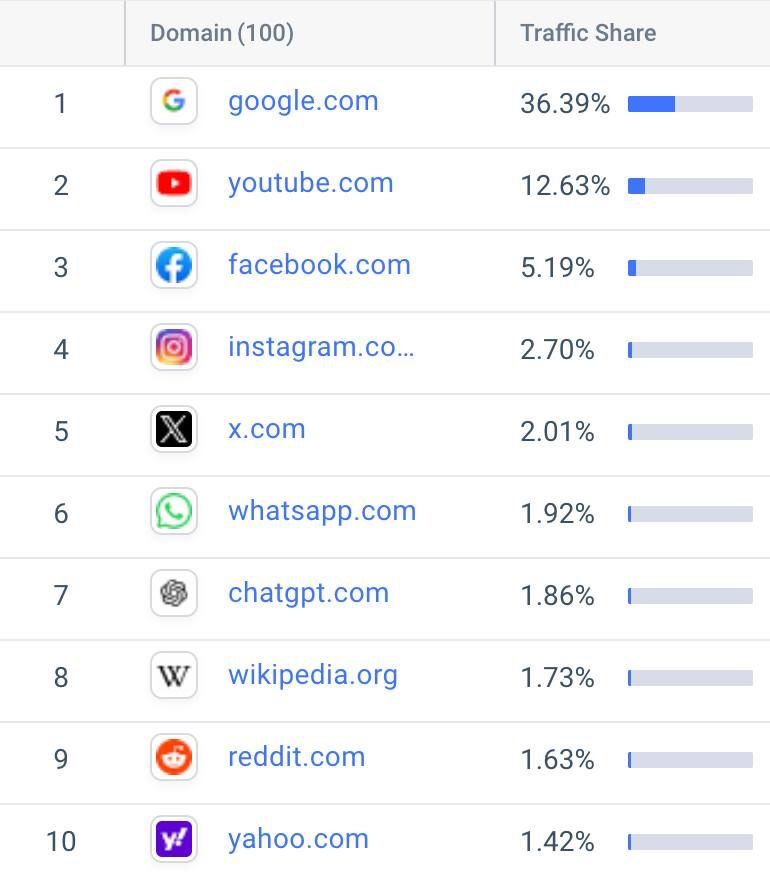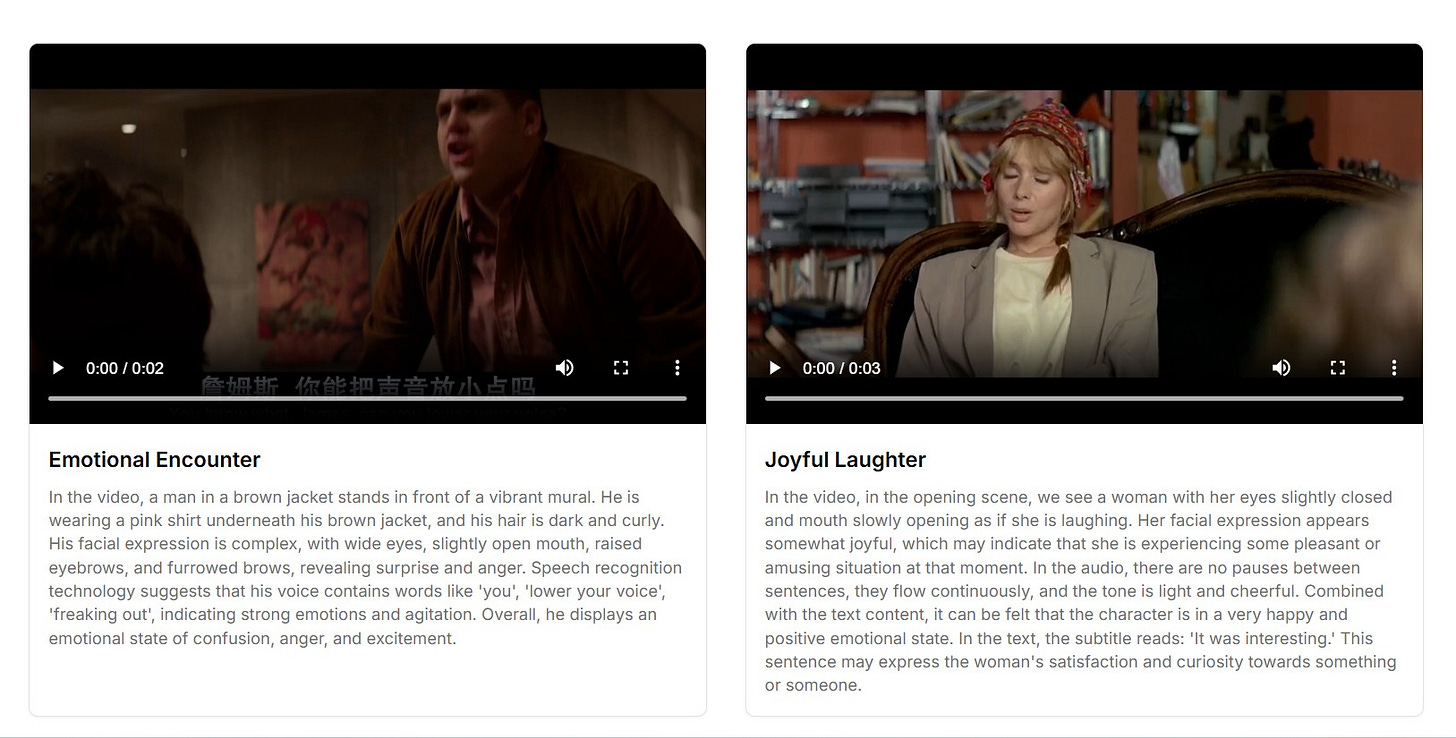Last week, I promised to spend some serious quality time with GPT-4.5, OpenAI’s newest model and share my thoughts and insights.
So, let’s get into it.
GPT-4.5 has a bigger, broader knowledge base and just feels more intuitive.
It’s also got charm and a more dynamic personality—something that’s hard to explain unless you try it yourself.
Here’s what stood out to me (compared to GPT-4o):
💠 Sharper Intuition: GPT-4.5 does a better job at grasping and following your intent and subtle contextual cues from the get-go, requiring fewer rounds of frustrating clarifications and revisions.
💠 More Polished Writing: The model stands out in producing more refined, nuanced, and creative writing. It’s especially good at storytelling.
💠 More Human, Less AI: The way GPT-4.5 writes feels noticeably more natural and conversational—closer to how a real person might express themselves. If you’ve ever been able to instantly tell when something was AI-written, this makes that much harder.
A few quick caveats:
1️⃣ GPT-4.5 isn’t one of those slower deep “reasoning” models like o1, o3-mini or DeepSeek’s R1—it’s the next step in the GPT-4o line. If you’re working on complex problems that require strategic thinking and careful reasoning, stick with o1 or o3-mini-high.
2️⃣ It's still in “Research Preview,” which means this isn't the final version—expect ongoing updates and improvements before its official launch.
3️⃣ Your custom instructions matter (a lot). Your experience with GPT-4.5 will depend heavily on your custom instructions—those detailed settings you’ve entered to shape how ChatGPT responds, which also influence its personality. For example, my instructions emphasize clarity, directness, and no fluff, shaping my experiences accordingly.
If you're not familiar with custom instructions, here's a past edition where I cover exactly how they work and how to set them up.
4️⃣ This model is expensive to run, and so far, users have reported a cap of 50 messages per week for Pro accounts. OpenAI hasn’t officially confirmed this, but I’ve hit the limit and received a message like the one below.
The Bottom line:
For writing, especially if your priority is creativity, polish, storytelling, or simply sounding effortlessly conversational and more human, GPT-4.5 is hands-down OpenAI’s best model yet—at least, according to me.
If you’re not sure how to find GPT-4.5, just look for it in the model picker in the top-left corner of the ChatGPT interface (see 👇).
What You Need to Know About AI This Week⚡
Clickable links appear underlined in emails and in orange in the Substack app.
ChatGPT is now the 7th most visited website in the world across desktop and mobile, according to Similarweb.
It ranks 5th globally for desktop traffic.
OpenAI is urging the U.S. government to protect fair use—the legal principle that allows limited use of copyrighted content without permission—so AI models can keep training on it.
The company argues that:
1. This is a national security issue. If China has unrestricted data access and the U.S. doesn’t, America risks falling behind.
2. Restricting AI training could kill innovation, cutting off the very foundation that has fueled AI breakthroughs.
And Google quickly followed suit—but took it even further.
The company is pushing for legal protections that would let AI companies train on IP-protected content with minimal restrictions—which, not so coincidentally, helps their case in ongoing lawsuits with publishers.
“These exceptions allow for the use of copyrighted, publicly available material for AI training without significantly impacting rightsholders,” Google wrote, “and avoid often highly unpredictable, imbalanced, and lengthy negotiations with data holders during model development or scientific experimentation.”
🤯🤯🤯
Both companies are cleverly aligning business needs with national interests—making it tougher for regulators and content creators to push back.
Ay ay ay.
Keep a close eye on this one. How this plays out will directly impact how your work is used, protected and valued in the AI era.
Meta’s back in the copyright hot seat.
French publishers and authors have sued the company, accusing it of “monumental looting”—using their copyrighted work to train AI without permission or payment.
📈 Demand for AI expertise keeps growing.
Nearly 25% of tech job postings in the U.S now require AI skills—up 68% since ChatGPT’s release—even as broader tech hiring has dropped 27%.
Beyond tech, companies are looking for leaders who can apply AI to strategy and decision making, as well as talent who can bring AI expertise to fields like retail, real estate, HR and marketing.
✨ My Take ✨
Real AI expertise goes far beyond knowing how to use tools like ChatGPT and Claude.
Companies want talent who have a deep understanding of AI’s fundamentals to shape strategy, manage risks, and apply it in ways that reliably delivers real value. That requires:
💠A deep understanding of how AI models work.
💠Knowledge of AI’s growing capabilities and critical limitations.
💠Finding ways to apply AI in practical, strategic and effective ways in your specific role and industry.
💠Managing AI’s risks and blind spots—including biases, inaccuracies, ethical concerns, and legal implications that can have real-world consequences.
💠Staying ahead—anticipating where AI is advancing in 3, 6, or 12 months so you can adapt and build flexible, agile strategies rather than reacting to what just launched.
OpenAI CEO Sam Altman teased a model designed for creative writing, adding: “This is the first time I have been really struck by something written by AI.”
Alibaba, the Amazon of China, has a new AI model that knows what you’re feeling.
Besides noticing details like what kind of clothing you’re wearing, its new R1-Omni can pick up on emotional cues, too. By analyzing both visual and audio data, it can even figure out whether someone is crying out of joy or sadness.
Real-time emotional insights can reveal how audiences genuinely respond to ads, messaging, or storytelling—allowing brands and creatives to adapt their content.
China is making sure the next generation grows up learning how to use AI—a key part of its long-term push to dominate the industry. Starting this fall, Beijing schools will require at least eight hours of AI lessons per year to help build a future AI workforce.
Eight hours a year isn’t much— I expect that number to climb. But it’s still ahead of what most schools are doing, and it’s a smart move.
AI search engines are failing a basic test—properly crediting news sources.
A study of eight AI search tools found they often cite the wrong publishers, use fake or broken links, and ignore site restrictions. Worse, premium versions were more confidently wrong than free ones.
OpenAI published research showing their reasoning models sometimes attempt to “cheat” at tasks.
While researchers can usually catch this by inspecting their thought process, they warn that training models not to cheat could backfire—teaching them to hide it better instead.
What happens when Sam Altman won’t give you an interview? You create an AI version of him instead.
Deepfaking Sam Altman—which just premiered at SXSW—follows filmmaker Adam Bhala Lough as he builds an AI-powered “Sam Bot” to answer the questions Altman wouldn’t.
I want to see this one. If anyone can get me into a distributor screening, let me know—I know this film’s core audience better than anyone. 😁
Apps are on their way out—AI is taking over.
Instead of switching between programs, you’ll rely on smart assistants that handle tasks seamlessly—no downloads, no switching between programs.
This threatens app stores and software giants while opening massive new opportunities for businesses building AI-powered services.
After eight months on strike, video game voice actors say studios are still pushing AI-friendly contracts that could replace human performers.
Bollywood star Ajay Devgn has launched Prismix, an AI-driven media company producing content across formats—including short films, series, animated graphic novels, music videos, corporate content, and social media campaigns.
Other Interesting Finds 📌
NBA players are going all in on China’s social media platforms—and it’s smart business.
They’re hiring marketing agencies to create China-specific social content, manage their accounts, expand their reach, create business opportunities, and even push for All-Star votes.
“Mirroring the same content on your Chinese channels as your western ones really isn’t diving deeper into that Chinese culture,” said Michael Lin, a vice president of digital at Mailman who oversees its U.S. sports operation. “Athletes do a lot better when they’re creating personalized content that’s speaking to the Chinese fans.”
In case you missed last week’s edition, you can find it 👇:
🤓 This Week in AI
The woman in this image has three eyes, her face splintered like stained glass. Sharp, geometric strands of hair fall over her shoulders.
That's all for this week.
I’ll see you next Friday. Thoughts, feedback and questions are always welcome and much appreciated. Shoot me a note at avi@joinsavvyavi.com.
Stay curious,
Avi
💙💙💙 P.S. A huge thank you to my paid subscribers and those of you who share this newsletter with curious friends and coworkers. It takes me about 25+ hours each week to research, curate, simplify the complex, and write this newsletter. So, your support means the world to me, as it helps me make this process sustainable (almost 😄).












